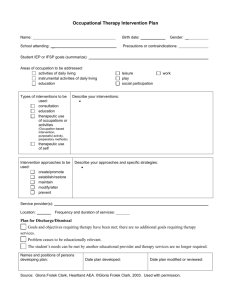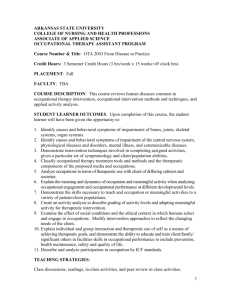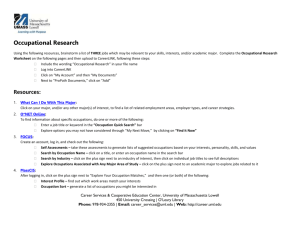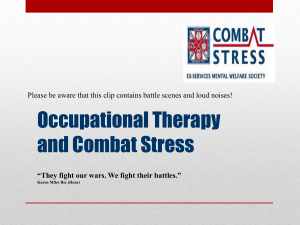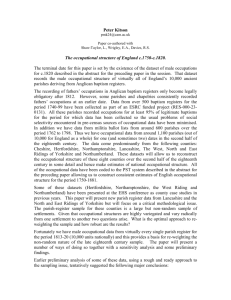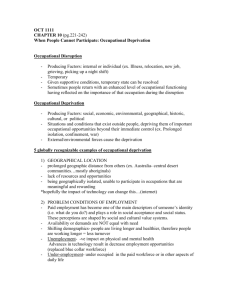References - Axis Clinic
advertisement
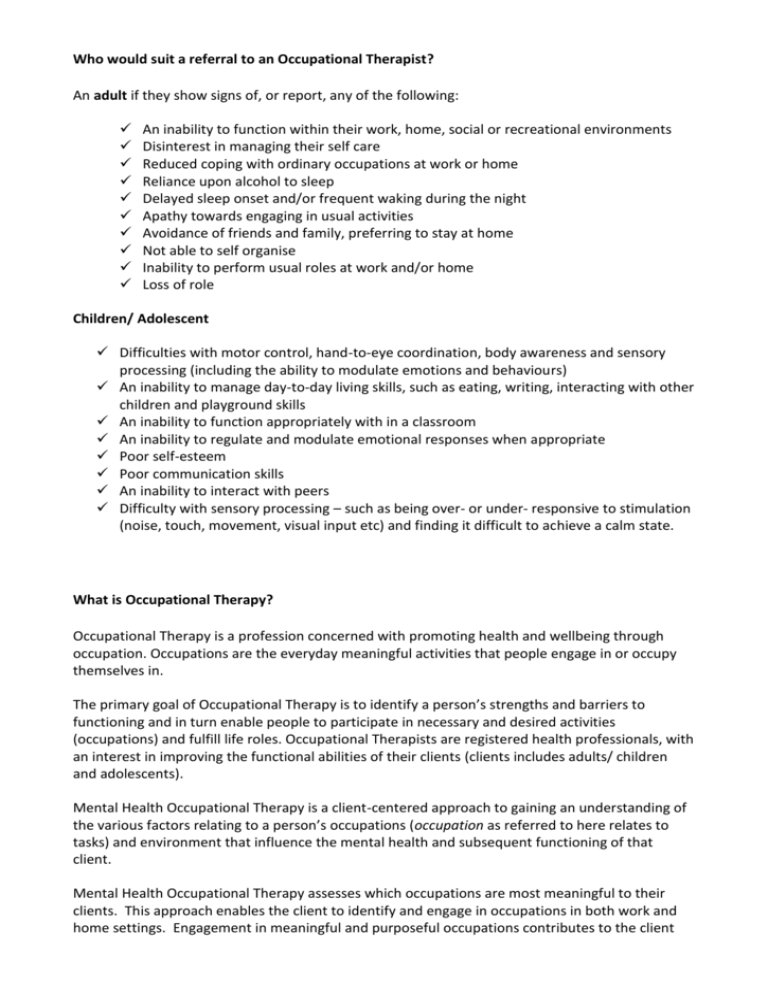
Who would suit a referral to an Occupational Therapist? An adult if they show signs of, or report, any of the following: An inability to function within their work, home, social or recreational environments Disinterest in managing their self care Reduced coping with ordinary occupations at work or home Reliance upon alcohol to sleep Delayed sleep onset and/or frequent waking during the night Apathy towards engaging in usual activities Avoidance of friends and family, preferring to stay at home Not able to self organise Inability to perform usual roles at work and/or home Loss of role Children/ Adolescent Difficulties with motor control, hand-to-eye coordination, body awareness and sensory processing (including the ability to modulate emotions and behaviours) An inability to manage day-to-day living skills, such as eating, writing, interacting with other children and playground skills An inability to function appropriately with in a classroom An inability to regulate and modulate emotional responses when appropriate Poor self-esteem Poor communication skills An inability to interact with peers Difficulty with sensory processing – such as being over- or under- responsive to stimulation (noise, touch, movement, visual input etc) and finding it difficult to achieve a calm state. What is Occupational Therapy? Occupational Therapy is a profession concerned with promoting health and wellbeing through occupation. Occupations are the everyday meaningful activities that people engage in or occupy themselves in. The primary goal of Occupational Therapy is to identify a person’s strengths and barriers to functioning and in turn enable people to participate in necessary and desired activities (occupations) and fulfill life roles. Occupational Therapists are registered health professionals, with an interest in improving the functional abilities of their clients (clients includes adults/ children and adolescents). Mental Health Occupational Therapy is a client-centered approach to gaining an understanding of the various factors relating to a person’s occupations (occupation as referred to here relates to tasks) and environment that influence the mental health and subsequent functioning of that client. Mental Health Occupational Therapy assesses which occupations are most meaningful to their clients. This approach enables the client to identify and engage in occupations in both work and home settings. Engagement in meaningful and purposeful occupations contributes to the client regaining a sense of achievement, self-esteem and well being that may have been affected by their injury/illness. Mental Health Occupational Therapists work alongside other health professionals and service providers to deliver services in the following ways: Assessment of functional ability which involves assessing the client’s ability to manage work and home roles and participate actively in these pursuits. Identification of barriers to a client’s functioning within their usual environments (work/ study and/or home) and developing collaborative strategies to overcome these barriers. In children and adolescents OT promotes normal development and stimulates learning to improve the child/adolescents quality of life by helping them to participate in play, preschool, school and home activities. Interventions to assist clients to overcome practical challenges including independent life skills/ self management, leisure and health/ social /fitness goals using focused occupational strategies. The treatment process uses activity scheduling, programming tasks, routine planning and skills development. This includes learning about anxiety, stress and sleep management, as well as concepts such as self esteem, anger management and assertive communication. Identified functioning requiring attention will be addressed with particular focus on their affect on the following skills: Productivity Skills empower the client to practice and develop skills that enable them to engage in work or participate in study or schooling. Self maintenance facilitates enhancement of the client’s independence in managing daily tasks and the prevention of relapse. Leisure and recreation skills provide opportunities for the client to engage in a range of options to develop interests that they can undertake independently in the community. Social skills underpin the client’s ability to progress in all of the above areas and provides increased confidence to relate with others effectively in a range of settings References: Based on Natalie Bottroff & Associates Pty Ltd. Back on Track Mental Health Occupational Therapy Kielhofner, G (Ed) (1985). A model of Human Occupation: Theory and Application. Williams & Wilkins, Sydney. Ranka, J & Chapparao, C (1996). “PRPP Research: Training Manual CPE edition 2.0” University of Sydney, Sydney Dunn, W, Borwn, C, McGuigan, A (1994). “The Ecology of Human Performance: A framework for considering the Effect of Context” The American Journal of Occupational Therapy Vol 48(7): 595-607.


